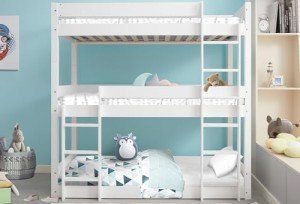The Ultimate Guide to Bunk Beds for Children: Safety, Styles, and Benefits
When it pertains to styling a kid's space, parents frequently face the double obstacle of maximizing space while guaranteeing convenience and functionality. Bunk beds have actually emerged as a popular service that resolves these needs, providing not simply sleeping plans however also adding to a room's aesthetic. In this extensive guide, we will explore different aspects of children's bunk beds, focusing on their advantages, safety functions, styles, and considerations for parents contemplating this purchase.
Tabulation
- Benefits of Bunk Beds
- Security Features to Consider
- Kinds Of Bunk Beds
- Design and Style Options
- Maintenance Tips
- Often Asked Questions (FAQs)
1. Advantages of Bunk Beds
Bunk beds offer many advantages for kids and their parents. Here are some crucial advantages:
Space-Efficiency: Bunk beds are an exceptional option for smaller spaces. By stacking one bed on top of another, more floor space is offered for play, storage, or research study locations.
Cost-efficient: When children share rooms, bunk beds can lower the requirement for acquiring 2 separate beds, thus saving money.
Cultivates Social Interaction: Bunk beds can help siblings or friends bond by sharing a space, developing chances for social advancement.
Enjoyable Factor: The idea of sleeping "up high" includes a playful aspect to bedtime, making the shift to sleeping alone simpler for some kids.
Versatile Design: bunk beds sales beds are available in different styles, colors, and creates to match any room theme, enabling customization that shows the kid's personality.
2. Safety Features to Consider
Safety is vital when it pertains to kids's furnishings, specifically in the case of bunk beds. Here are some critical safety functions to evaluate:
| Safety Feature | Description |
|---|---|
| Tough Construction | Frames made of strong wood or metal are chosen. |
| Guardrails | Should be at least 5 inches high and extend along both sides of the upper bunk. |
| Ladder Design | Make sure ladders are safely attached and have non-slip steps. |
| Mattress Size & & Fit | Need to fit snugly within the frame to prevent gaps. |
| Weight Limit | Always comply with the maker's weight limit suggestions. |
3. Kinds Of Bunk Beds
Bunk beds are available in a number of designs, catering to different requirements, preferences, and space sizes. Here are some common types:
Standard bunk beds children's - Caterina blog article - Bed: The many basic type, with one bed on top of another.
Loft Bed: Features a high upper bed with space underneath for a desk or play location.
Futon Bunk Bed: Combines a leading bunk with a futon on the bottom, supplying versatility for seating and sleeping.
L-Shaped Bunk Bed: This design has the leading bunk set at a perpendicular angle to the bottom, developing a little corner area.
Triple Bunk Bed: Accommodates 3 children utilizing stacked beds, perfect for large households or slumber parties.
4. Design and Style Options
When it comes to choosing a style for children's bunk beds, the choices are essentially limitless. Here are some popular styles:
Traditional Style: Often made from wood, these bunk beds include elaborate information and are perfect for classic or rustic-themed rooms.

Modern Style: Characterized by clean lines and minimalist designs, contemporary bunk beds can be made from metal or wood.
Themed Bunk Beds: Some brands use bunk beds shaped like castles, vehicles, or play houses, making bedtime less of a chore.
Convertible Bunk Beds: These can be separated into two private beds, offering versatility as children grow.

Colorful Options: Bunk beds in lively colors can add a sense of joy and playfulness to any room.
5. Upkeep Tips
Keeping a bunk beds cheap bed is crucial for durability and safety. Here are some pointers:
Regular Inspections: Check for loose screws or bolts every few months and tighten them as required.
Cleaning up: Wipe down frames frequently to avoid dust accumulation; think about utilizing a vacuum for hard-to-reach areas.
Mattress Care: Rotate mattresses frequently and utilize protective covers to prolong their life.
View for Wear and Tear: Look for any indications of damage in the wood or metal and think about replacing parts if needed.
Teach Kids Safety Rules: Encourage children to utilize ladders appropriately and ensure they understand the safety features of their bed.
6. Often Asked Questions (FAQs)
Q1: What age is appropriate for sleeping in a leading bunk?
A1: Typically, children aged 6 and older are advised for upper bunk sleeping, as they have the needed motor skills to climb safely.
Q2: Do bunk beds feature a mattress?
A2: Most bunk beds for kids beds are sold as frames only, so you will need to purchase mattresses individually. Guarantee that the bed mattress fits the frame snugly.
Q3: Can bunk beds be separated later?
A3: Many designs allow conversion into 2 individual beds, supplying flexibility for future requirements.
Q4: How can I ensure my child's safety on a bunk bed?
A4: Comply with safety requirements and guarantee guardrails, a tough frame, and a secured ladder remain in location.
Q5: Are there weight limitations on bunk beds?
A5: Yes, constantly inspect the maker's specs concerning weight limits to ensure security.
Bunk beds for children can serve several purposes while ensuring safety and design. With diverse styles and designs offered on the market, parents can find a system that not just makes the most of bed room space but likewise shows their child's distinct tastes. Just like any furniture, understanding security features, maintenance, and how they suit a child's way of life will make sure that these beds remain a practical furnishings solution for several years to come.
Through careful factor to consider and adherence to safety standards, bunk beds can offer a long-lasting, enjoyable, and practical sleeping solution that children like.







